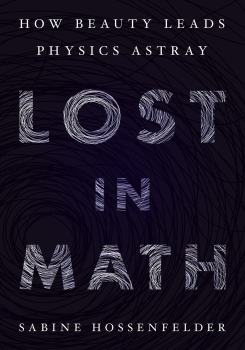The Alluring Beauty Of Supersymmetry
In this excerpt from “Lost in Math,” Sabine Hossenfelder explains how the idea of supersymmetry is just too beautiful for scientists to ignore.
The following is an excerpt of Lost in Math: How Beauty Leads Physics Astray by Sabine Hossenfelder.
I’ve noted on our quest to understand what the world is made of, we have found twenty-five different elementary particles. Supersymmetry completes this collection with a set of still undiscovered partner particles, one for each of the known particles, and some additional ones. This supersymmetric completion is appealing because the known particles are of two different types, fermions and bosons (named after Enrico Fermi and Satyendra Bose, respectively), and supersymmetry explains how these two types belong together.

Lost in Math: How Beauty Leads Physics Astray
Fermions are extreme individuals. No matter how hard you try, you will not get two of them to do the same thing in the same place—there must always be a difference between them. Bosons, on the other hand, have no such constraint and are happy to join each other in a common dance. This is why electrons, which are fermions, sit on separate shells around atomic nuclei. If they were bosons, they would instead sit together on the same shell, leaving the universe without chemistry—and without chemists, as our own existence rests on the little fermions’ refusal to share space.
Supersymmetry postulates that the laws of nature remain the same when bosons are exchanged with fermions. This means that every known boson must have a fermionic partner, and every known fermion must have a bosonic partner. But besides differing in their fermionic or bosonic affiliation, partner particles must be identical.
Since none of the already known particles match as required, we have concluded there are no supersymmetric pairs among them. Instead, new particles must be waiting to be discovered. It’s like we have a collection of odd pots and lids and are convinced that certainly the matching pieces must be around somewhere.
Unfortunately, the equations of supersymmetry do not tell us what the masses of the susy [supersymmetry] partners are. Since it takes more energy to produce heavier particles, a particle is more difficult to find when its mass is larger. All we have learned so far is that the superpartners, if they exist, are so heavy that the energy of our experiments isn’t yet large enough to create them.
Supersymmetry has much going for it. Besides revealing that bosons and fermions are two sides of the same coin, susy also aids in the unification of fundamental forces and has the potential to explain several numerical coincidences. Moreover, some of the supersymmetric particles have just the right properties to make up dark matter.
Supersymmetry fits so snugly with the existing theories that many physicists are convinced it must be right. “Despite the efforts of many hundreds of physicists conducting experiments in search of these particles, no superpartners have ever been observed or detected,” writes Fermilab physicist Dan Hooper. Yet “this has had little effect in deterring the theoretical physicists who passionately expect nature to be formulated this way—to be supersymmetric.
To many of these scientists, the ideas behind supersymmetry are simply too beautiful and too elegant not to be part of our universe. They solve too many problems and fit into our world too naturally. To these true believers, the superpartner particles simply must exist.”
[Your physics questions, explained.]
Hooper isn’t the only one to emphasize the strength of this conviction. “For many theoretical physicists, it is hard to believe that supersymmetry does not play a role somewhere in nature,” notes physicist Jeff Forshaw. And in a 2014 Scientific American article titled “Supersymmetry and the Crisis in Physics,” particle physicists Maria Spiropulu and Joseph Lykken support their hope that evidence will come in, eventually, with the assertion that “it is not an exaggeration to say that most of the world’s particle physicists believe that supersymmetry must be true” (their emphasis).
It adds to susy’s appeal that a symmetry relating bosons and fermions was long thought impossible because a mathematical proof seemed to forbid it. But no proof is better than its assumptions. It turned out that if the proof’s assumptions are relaxed, supersymmetry instead is the largest possible symmetry that can be accommodated in the existing theories. And how could nature not make use of such a beautiful idea?
Adapted from Lost In Math: How Beauty Leads Physics Astray by Sabine Hossenfelder, with permission from Basic Book, an imprint of Perseus Books, LLC, a subsidiary of Hachette Book Group, Inc. Copyright © Sabine Hossenfelder, 2018.
Sabine Hossenfelder is a research fellow at the Frankfurt Institute For Advanced Studies and author of Lost In Math: How Beauty Leads Physics Astray (Basic Books, 2018). She’s based in Frankfurt, Germany.